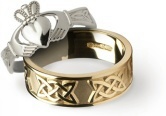Blog Categories
Blog CategoriesCelts in the Headlines - National Geographic Spotlights the Celts around the World
 |
The Celts are back in the headlines with an extensive photo essay featured in the acclaimed National Geographic magazine detailing their importance and the impact that they made across the world.
Irish and Celtic traditions are still very much alive and many of them are still carried on in Ireland and around the world through song, music, jewelry and culture. However this article by Borja Pelegero traces their history and asks ‘Who were the Celts?’ and looks back at this Iron age culture with settlements stretching from Ireland to Turkey. They used their metalworking skills to build extensive trade networks with ancient Greece and Rome.
The article points out that “today, the word “Celtic” represents many things: a style of modern jewelry; a typeface and an epithet of national pride among people of Scottish, Welsh, and Irish descent. In historical terms, however, “Celtic” is harder to define, in part because the Celts lived across such a wide area, inhabiting lands from Ireland to Turkey.”
It quotes Barry Cunliffe, emeritus professor of European archaeology at Oxford, who believes that the Celts can be understood as a culture with shared belief systems and a common language, versions of which are still spoken in western Europe, especially in Ireland and Scotland. In this spirit, historians now regard Celtic culture not in terms of a unified people, but as a bundle of shared linguistic and cultural traits distributed among various Iron Age peoples who profoundly shaped pre-Roman Europe.
The article gives a great insight into how at first the Celts were noted for their trading habits and then later for their warlike nature. One of the most important periods in Celtic culture was the La Tène culture which was a really significant time when it came to jewelry as it was the time of some of the most iconic motifs associated with Celtic culture today: interlaced geometric designs, rooted in complex belief systems that historians are still unraveling. The reach of the La Tène culture was extensive: It had spread to the British Isles by around 400 B.C.
 |
| Celtic Crosses |
The Celtic cross is one of the most easily recognized sacred symbols in the world. There are Celtic crosses dotted around Ireland and the beautiful and intricate engravings are the inspiration for one of the most beautiful jewelry collections at Rings from Ireland. The Celtic knot in particular is a beautiful embellishment on any piece from necklaces to rings to earrings and is timeless.
 |
| Celtic Rings |
Jewelry and metalwork from this period featured very intricate spirals and geometric designs and the pieces ranged from gold to silver to bronze. The Trinity knot was another prominent Celtic knot and has no start or finish and is said to represent eternity, loyalty, friendship, faith, love and the interconnection of life.
Strong, creative and spiritual … the Celts made their mark when they first emerged and their traditions and culture and motifs are still relevant to this day in Ireland and across the world.
